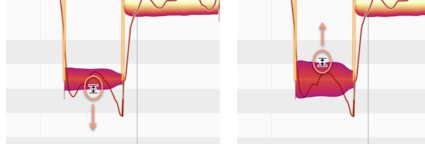Amplitude Tool
-
The leveling tools– Hands-on film about the dynamic functions: inter alia the Fade Tool and the Leveling Macro. Shown here: Melodyne 5 studio, smaller editions may differ.
The Amplitude Tool allows you to adjust the amplitude (i.e. volume) of the selected notes, edit the amplitude transitions between them, and mute them.
Editing amplitude
Select the Amplitude Tool from either the toolbox or the context menu of the Note Editor or by pressing the [F4] key of your computer keyboard. (If you wish to assign a different shortcut to this tool, you may do so after choosing Melodyne > Preferences > Shortcuts > Editing Tools from the main menu.)

With the tool selected, click on a note (or one of several notes selected) and – without releasing the button – drag the mouse up or down. The vertical depth of the blobs will increase or decease as the notes they represent get louder or softer.

The gearing of the amplitude adjustment is dependent upon the vertical zoom resolution. Press and hold the [Alt] key, to switch to smaller increments for finer adjustment.
Editing amplitude using the inspectors
As an alternative to editing selected notes with the Amplitude Tool, you can enter the desired values in the inspector to the right of the toolbar or the Note Inspector. Drag the existing value to change it or double-click on it and type in the value desired. Press and hold the [Alt] key, to switch to smaller increments for finer adjustment.

If you have selected several notes to which different amplitude adjustment has been applied, a dash is displayed in the box – followed, as you click in the box and drag, by values describing the extent of the relative change.
Amplitude transitions
A thick orange line appears between connected notes as soon as you change the amplitude of one note more, or in a different direction, than that of the other. This line represents the amplitude transition between the two notes. If you move the Amplitude Tool to the end of the first note, it changes into the Amplitude Transitions Tool. Dragging vertically with this tool governs the speed of the amplitude transition, which is indicated by the steepness of the connecting line.

Amplitude transitions only exist in the case of connected notes between which there is a soft note separation. If you double-click on the separation with the Separation Type Tool (which you will find beneath the Note Separation Tool in the toolbar), you turn the soft note separation into a hard one, thereby disconnecting the two notes and deactivating the amplitude transition.
Muting notes
Double-clicking with the Amplitude Tool on one or more selected notes mutes them. Only the outline of the blobs is now shown, to indicate that the notes in question have been muted, but you can still select and edit them. A further double-click unmutes the muted notes.

In the Note Inspector, you will find a button marked Note Off for this function. Click once on the button to mute the selected notes. Clicking them a second time unmutes them.
The reset commands
In the Edit > Reset Individual Edits > Amplitude cascading menu, you will find two commands that can be used to reverse the effects of the two types of amplitude editing we have just described (thereby restoring the notes selected in certain respects to their original state) as well as the Unmute command, which is self-explanatory. These commands relate always to the current selection and are grayed out if no editing of the type in question has been applied to the selected notes. Note that these commands operate independently of the normal undo function.
